With two volcanoes dominating this island, Ometepe is a feast for the eyes but also features a great insight to Nicaragua's culture. We follow along with veteran guide Victor as Dale of the Maritime Explorer explains how their group trip to Ometepe went.
This is my fourth post on the country of Nicaragua which Alison and I are visiting as part of Victor Romagnoli’s Central America tour on behalf of Canadian travel company Adventures Abroad. One of the attractions for me in choosing this trip was the opportunity to see volcanoes, lot’s of them and Nicaragua fits that bill perfectly. In my last post we visited the active volcano Masaya and stared into what the Spaniard’s called ‘The Gates of Hell’. Today we are going to take a ferry to Ometepe Island in Lake Nicaragua where we will see two of the country’s most famous volcanoes, Concepción and Maderas as we do a near circumnavigation of the island. It promises to be a great excursion and I invite you to come along.
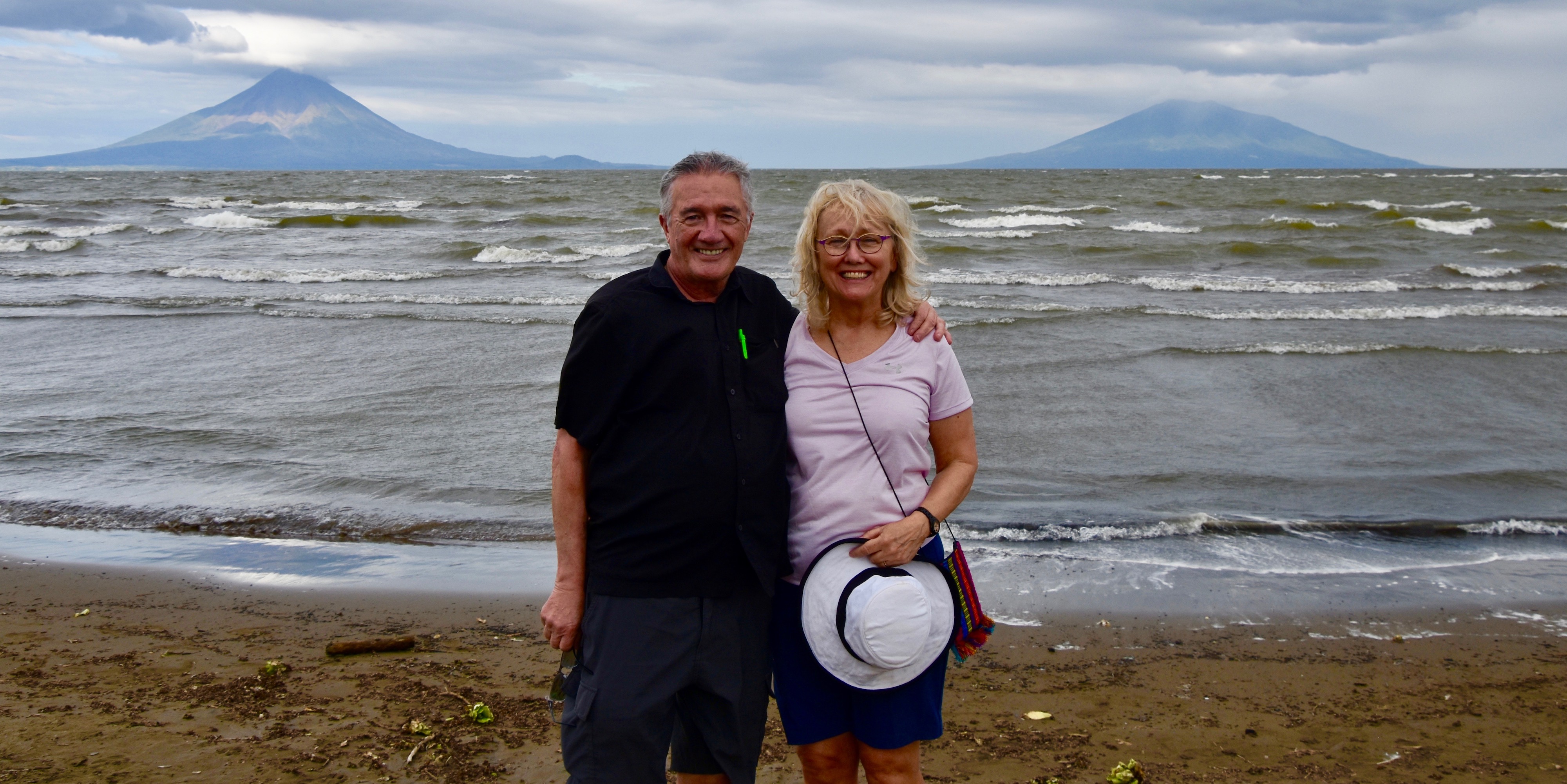
Almost from the moment you cross the border from Costa Rica to Nicaragua the presence of Lake Nicaragua and the two huge volcanoes that seem to sprout right out of its waters are a dominating feature of the landscape. Long before we reached our destination of Granada our bus pulled off the highway near a small lane that led to the lakefront and we got out to survey the amazing scene which simply demands that you stand in between the two volcanoes and take a picture like the one above. Victor promised that in a few days we would get a much closer look as we crossed to Ometepe Island and today’s the day.
As an aside I couldn’t help but notice these little girls having a mud ball fight near the shoreline. Nicaragua might be a police state and a dictatorship, but they don’t know it yet; they are still Babes in Toyland.
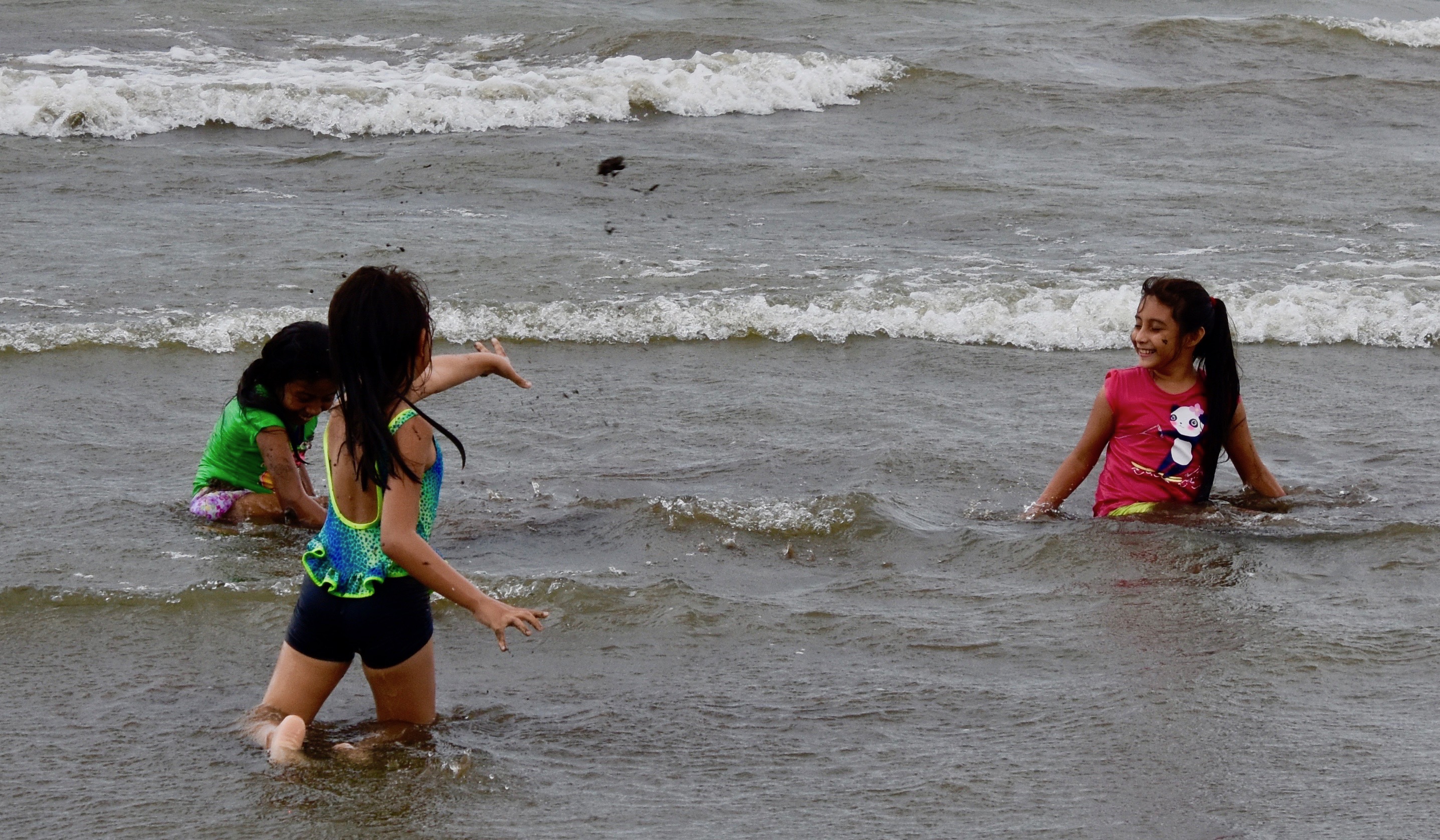
Some Facts About Ometepe Island
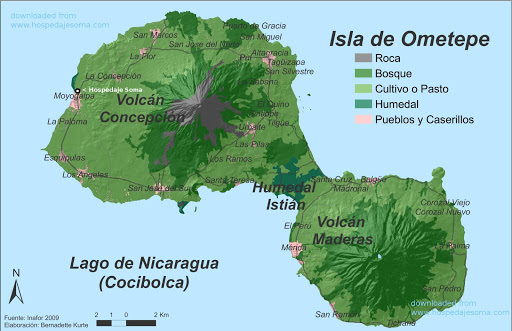
Ometepe is a Nahuatl word meaning ‘two mountains’ which for once makes plain sense as you can see from the map. For an island in a lake it’s quite large at 267 sq. kms. or 107 sq. miles with a length of 31 kms. (19 miles) and a maximum width of 10 kms. (6.2 miles). Surprisingly, to me at least, there are almost 30,000 people living here, most making a living as agriculturalists, fishermen or in cattle raising although tourism is beginning to be a major employer. People a lot younger than me are drawn here to climb to volcanoes and veg out along the shores of the lake. Victor was once one of them, having climbed Concepción on more than one occasion. Nobody on our group will be doing that today – in fact, just the thought of it makes my knees ache.
Historically, people have inhabited Ometepe for thousands of years and we will be making a stop to look at some of the ancient artifacts that have been found on the island. Not long after the Europeans arrived in the New World Ometepe became the frequent target of pirates who came up the San Juan River from the Caribbean and pillaged and looted the place forcing the inhabitants to flee to higher ground. That lasted well up into the 18th century before a sense of normalcy returned and now the pirates all live in Managua. Given the beauty of the island with its two volcanoes, lush tropical forest and bucolic atmosphere away from the few towns, it’s a natural magnet for people like me who relish nothing more than boarding a ferry to explore a new island destination. I suspect most in our group have the same heightened sense of expectation.
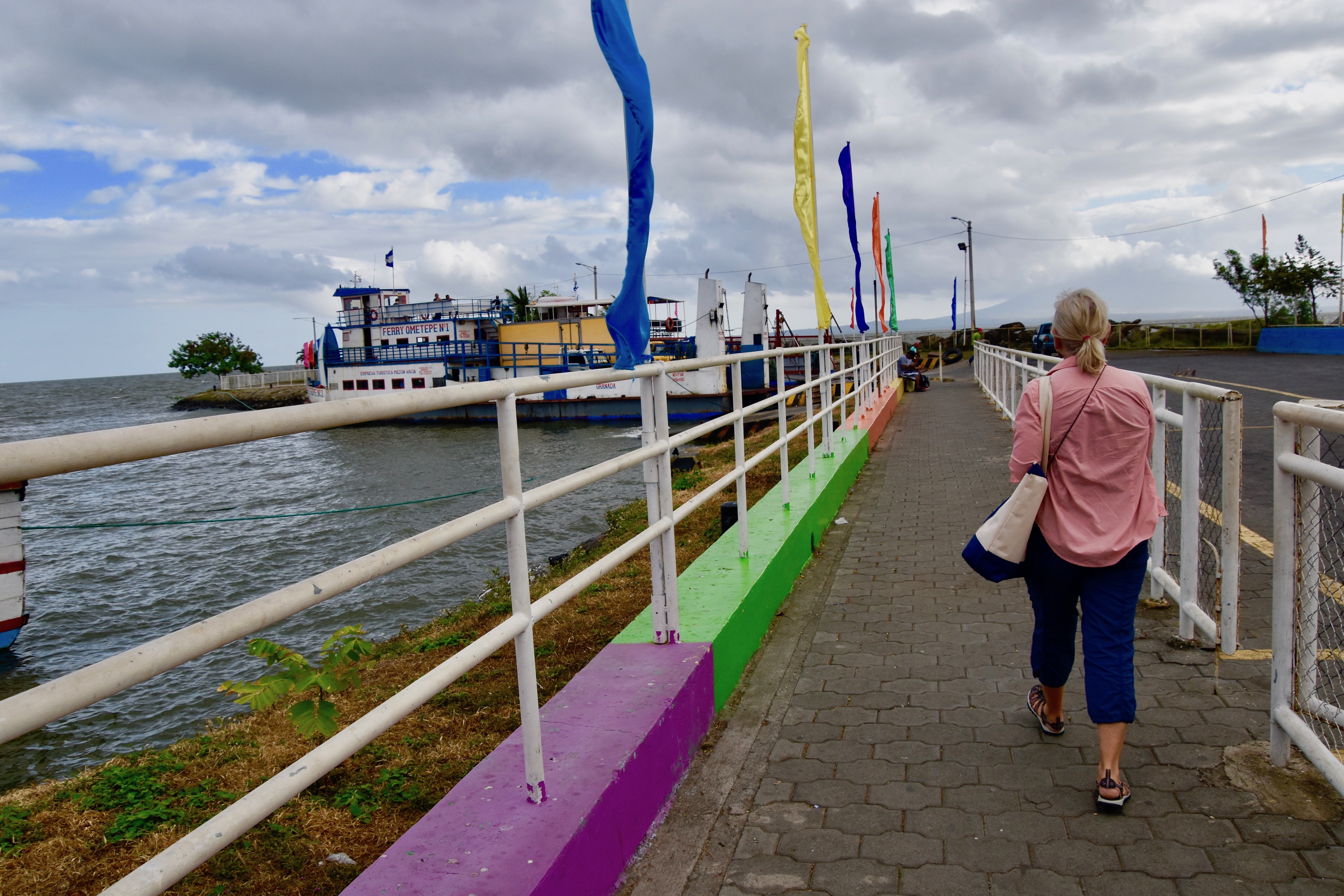
It’s about an hour or so drive south from Granada to the small city of Rivas and the nearby port of San Jorge where the ferries depart for Ometepe. They take mostly passengers, but also a few cars and trucks, one of which was loaded with frozen chickens destined for the island’s markets. The lake is a lot calmer than a few days before when we first sighted it, which is a pleasant surprise. All are required to wear life jackets and most of us head to the top deck for the best view.
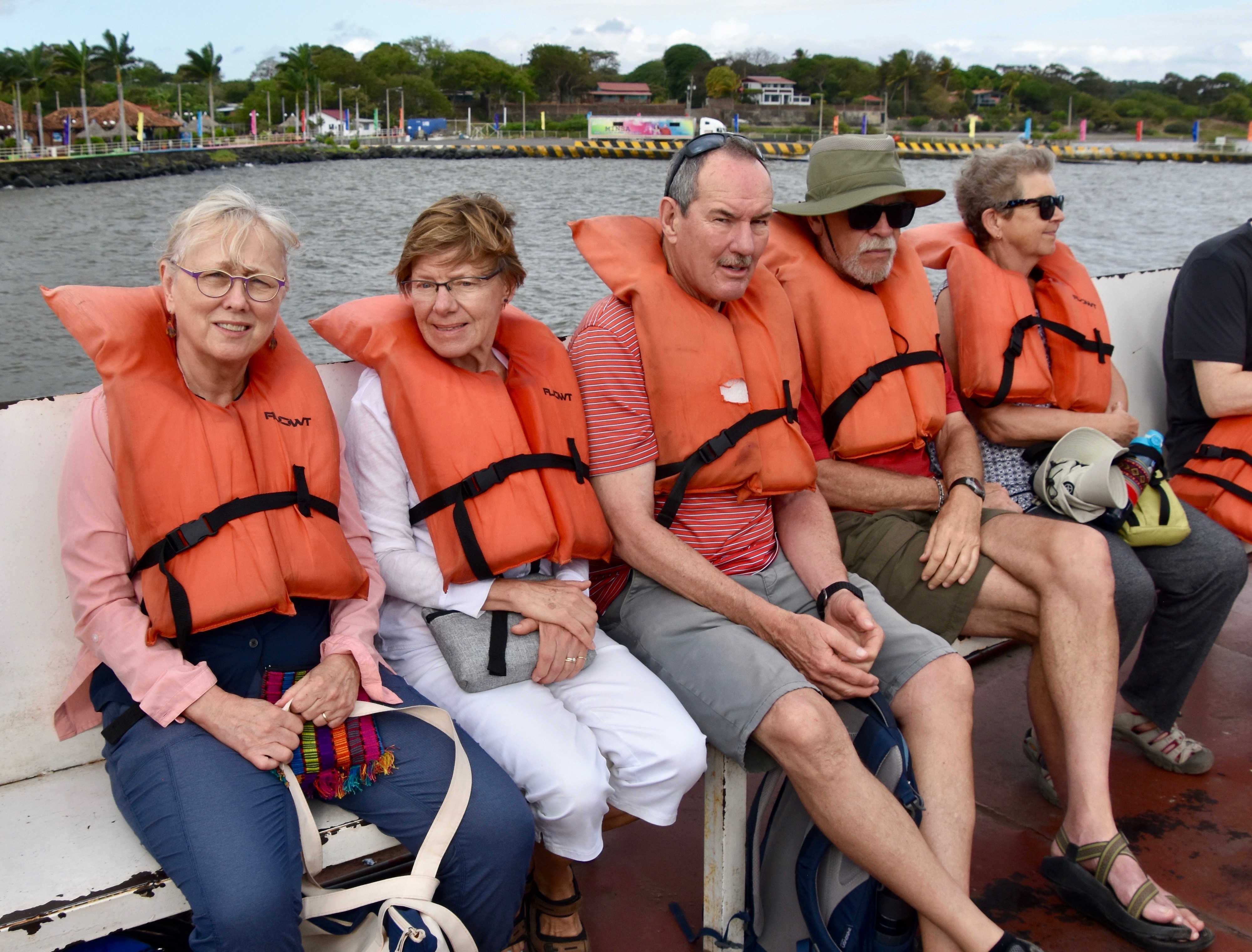
The trip takes a little over an hour to the small town of Moyogalpa and while I was hoping that the mist that shrouds most of Concepción volcano will lift, it doesn’t. Maybe later.
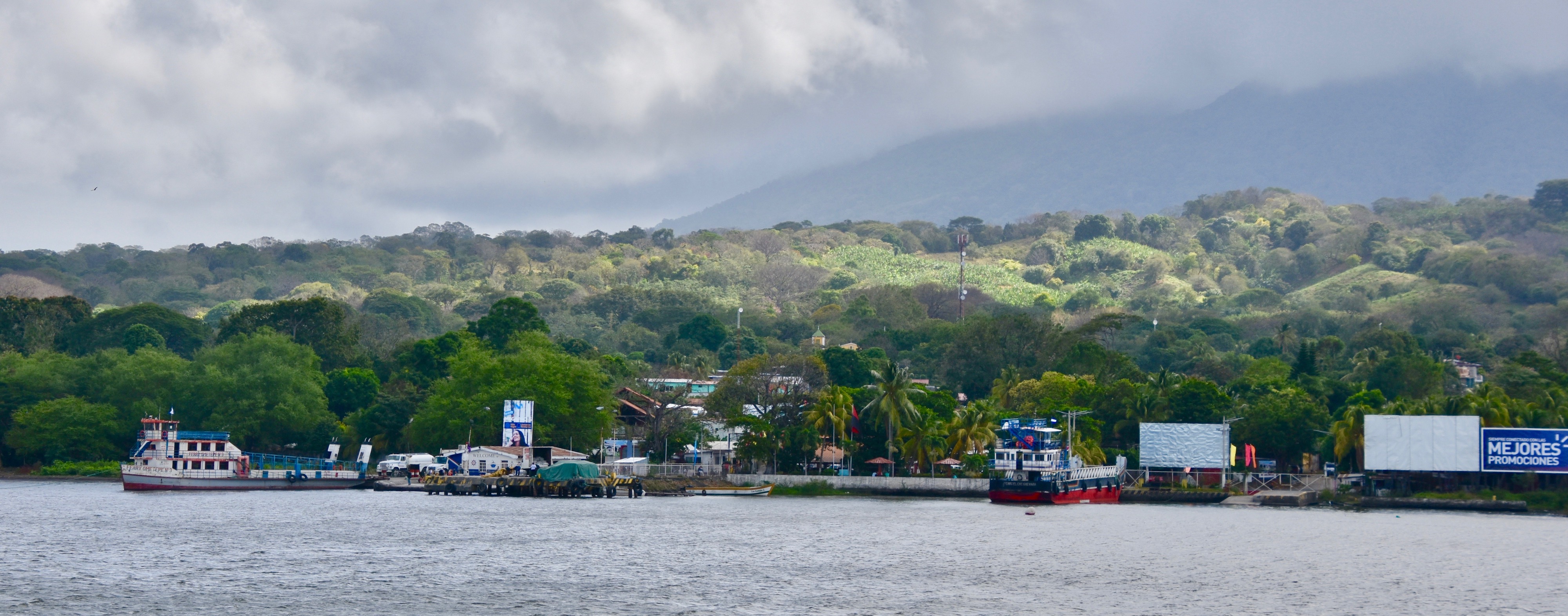
There is quite a welcoming crew awaiting us as we approach the landing pier. Well actually they are just passengers waiting to board and head back to the mainland. As you can see they are mostly young and white – the proverbial backpackers from Europe, the USA, Canada and Australia.
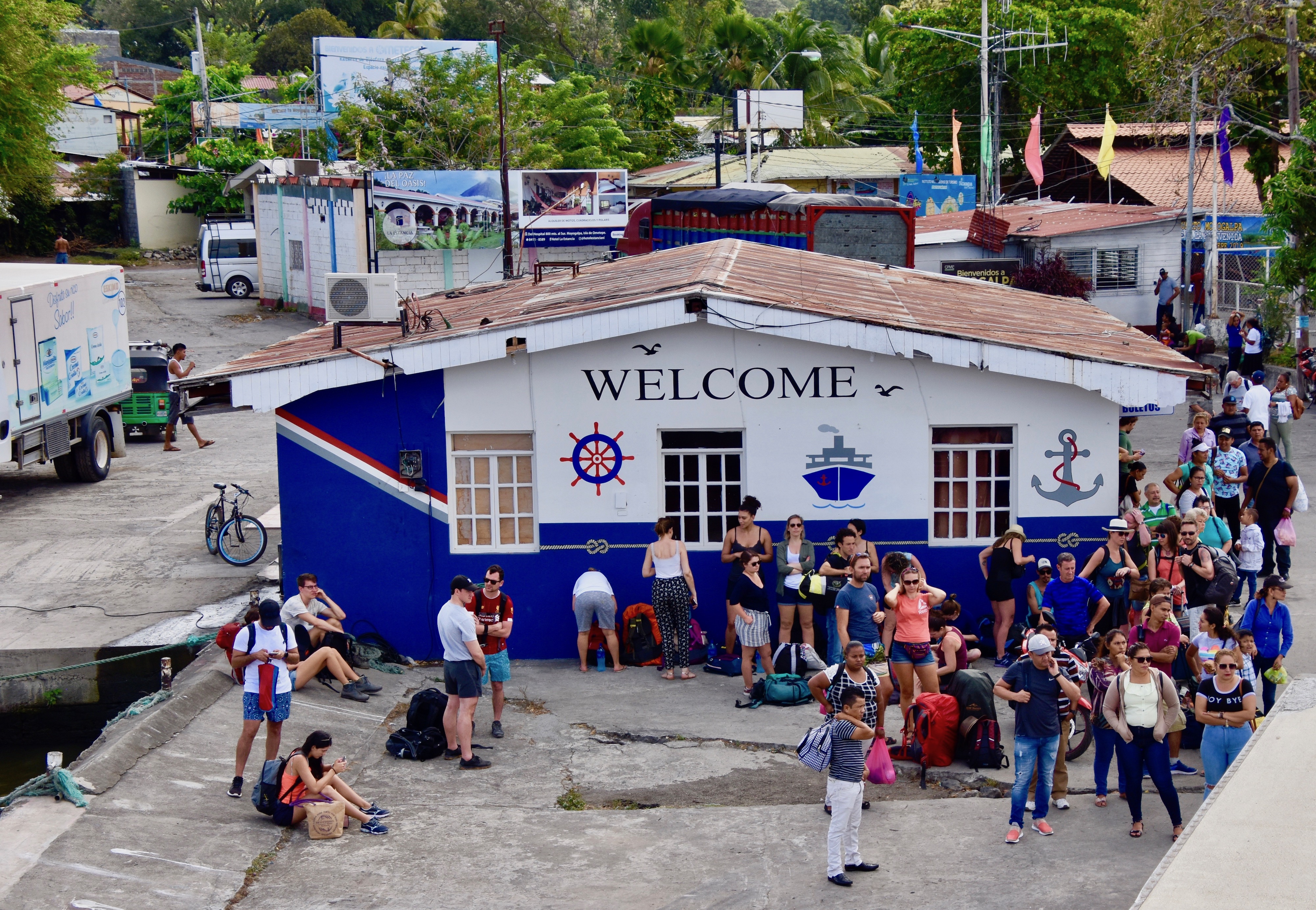
Our local guide Aura leads us off the boat and up the main street of Moyogalpa which fashions itself a city, but is actually a town of about 1,500.
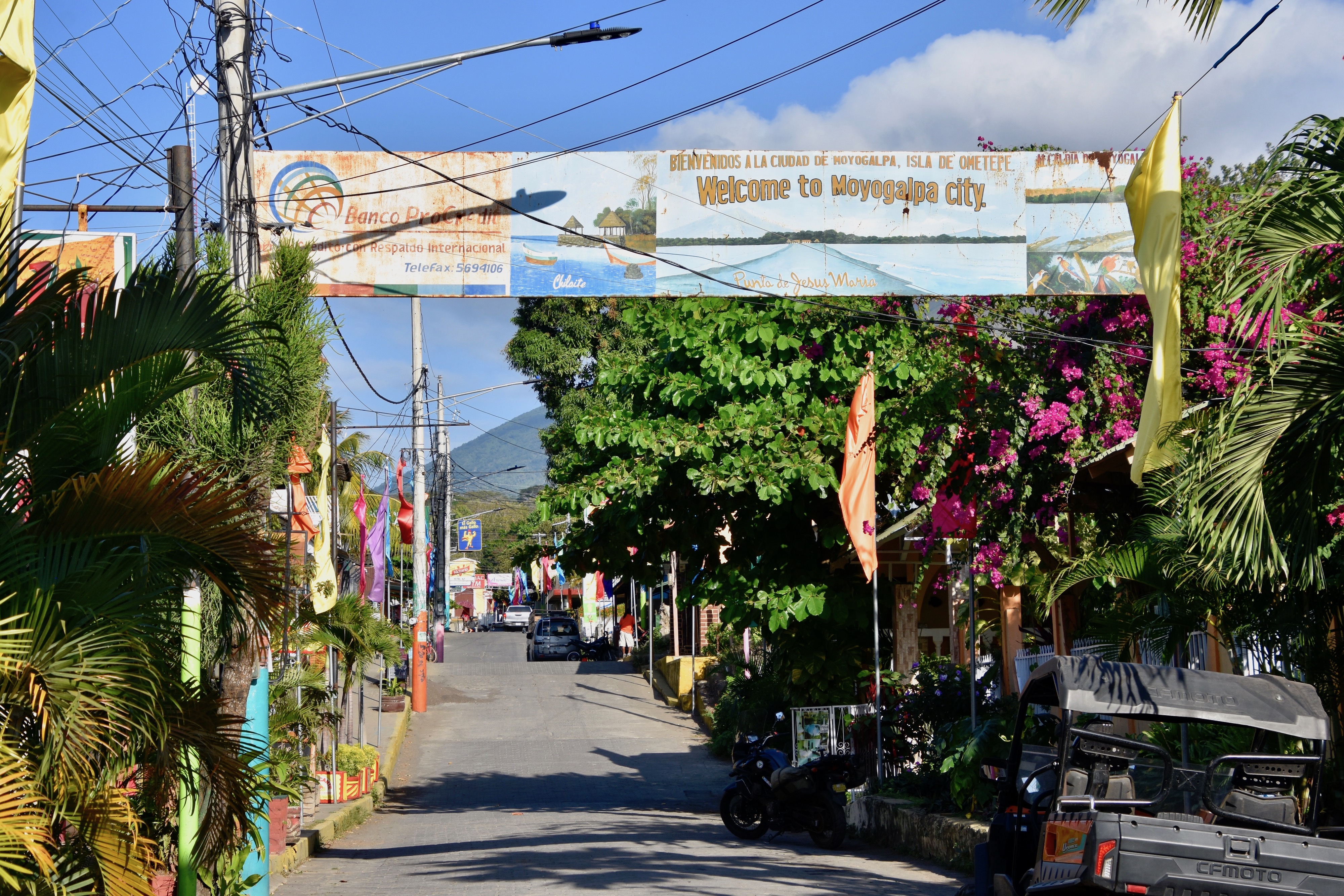
At the intersection of the two main arteries a street meat vendor has her works on display. Remind me to go for the chicken at lunch.
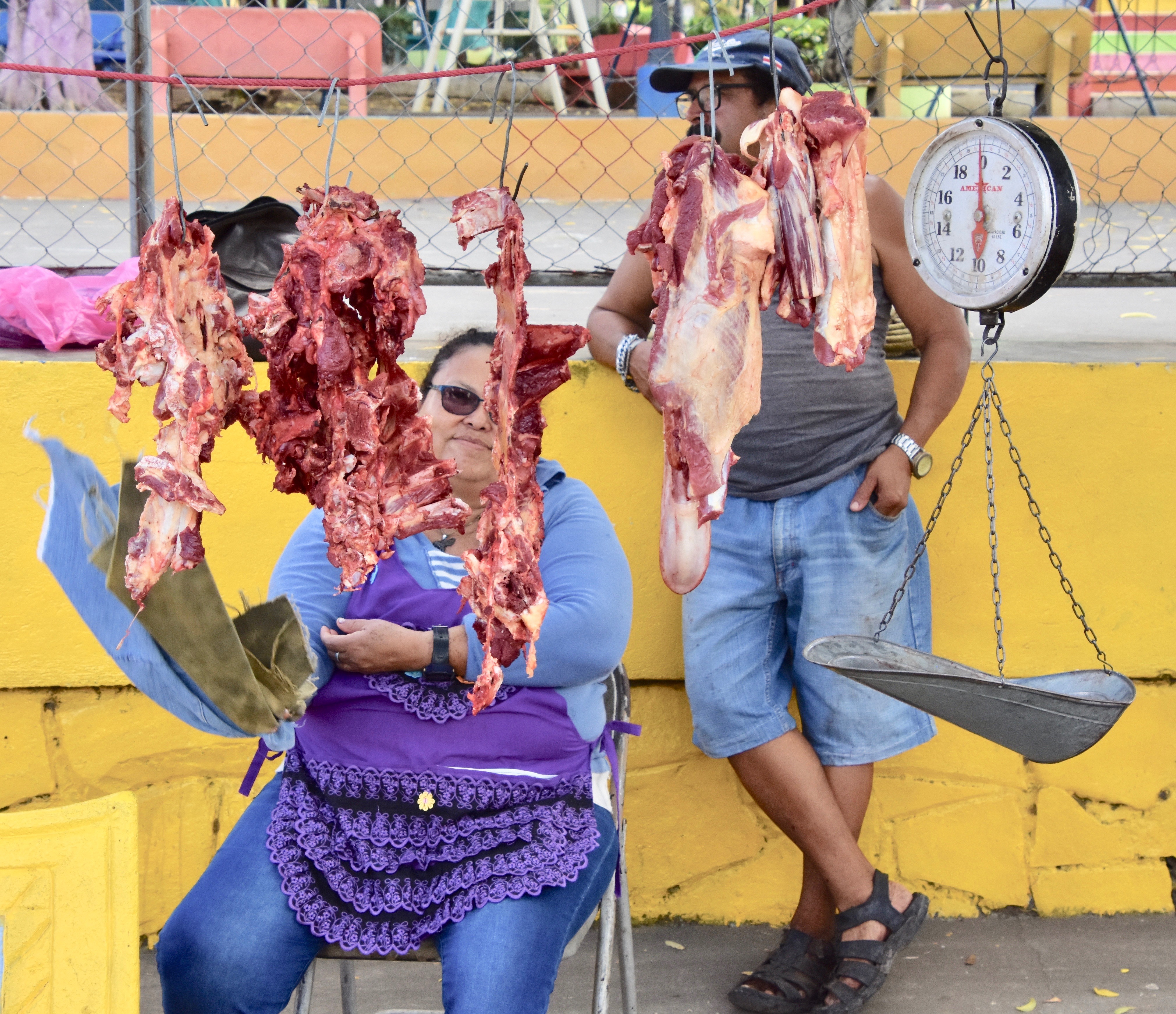
After the mandatory, but mercifully brief stop at the town’s Catholic church we board two vans and begin our exploration of Ometepe Island.
Not far out of Moyogalpa we turn down a narrow country lane and stop at the end of the road where the only other vehicle is an RV with a French license plate. How it would get to this remote place is beyond me, but sure enough just a ways down the beach we are headed to is a young family speaking French. Looking around I can certainly see the attraction – a beautiful black sand beach that leads out onto a spit of land where our group gathers, taking in the view of Concepción.
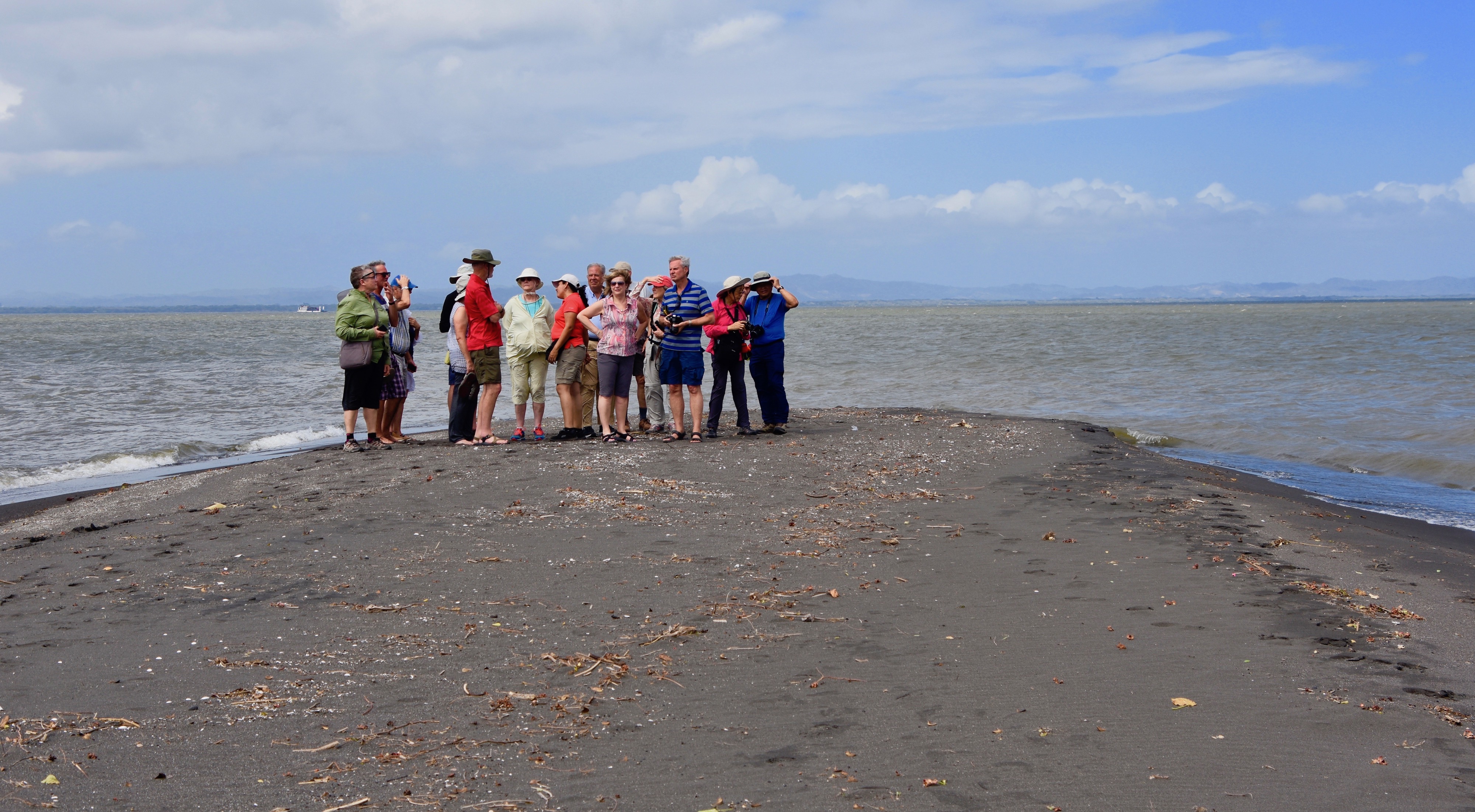
This is the view looking back to Concepción. I don’t think the words ‘tropical paradise’ would be out of place here. The water is deliciously warm on my toes and there are a number of interesting shells that Alison and I gather to add to our collection back home.
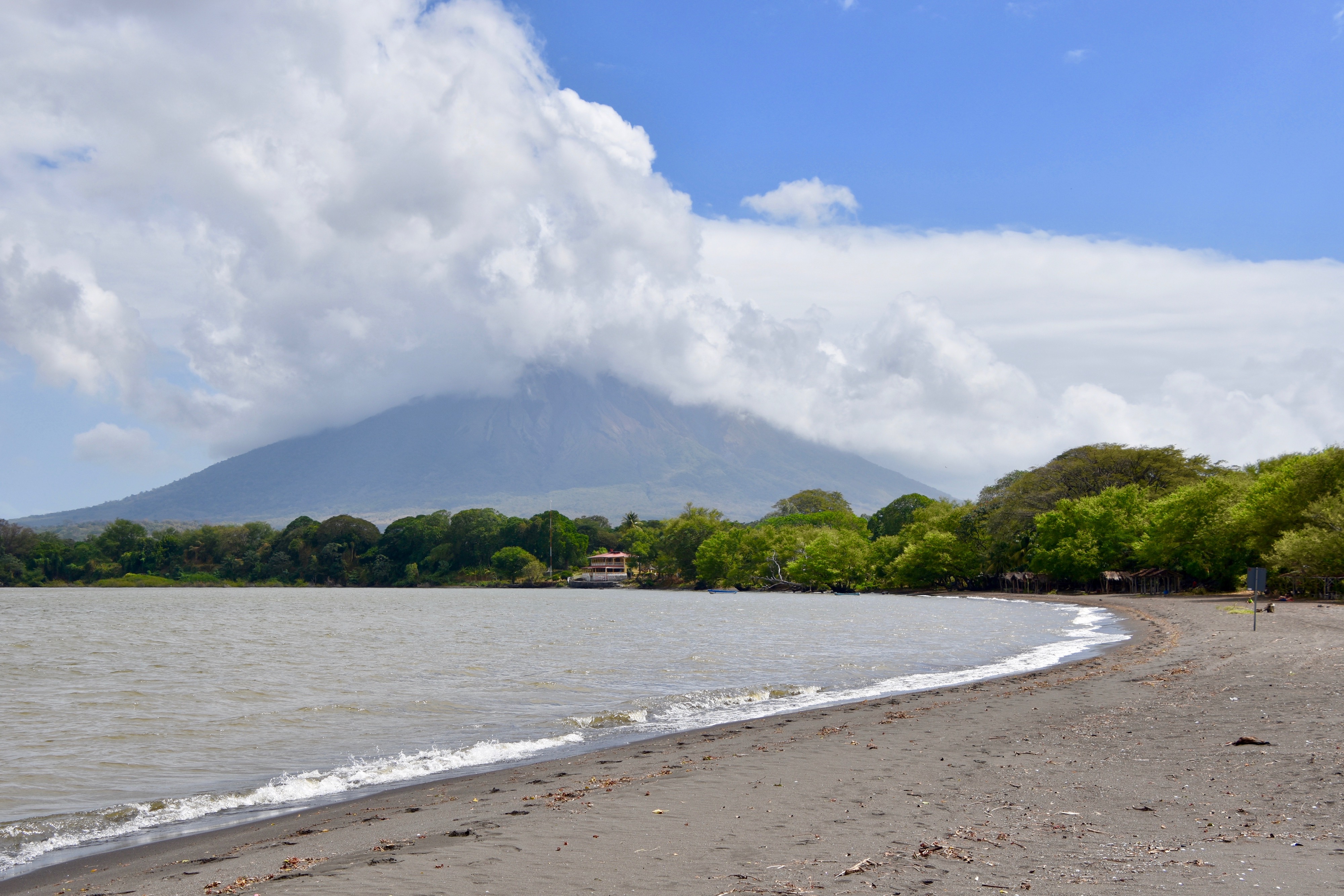
There are a number of palapas back from the beach including one under construction the old fashioned way – using just one tool, a very sharp machete and some swift and accurate blows upon the small trees that have been felled. Somehow the noise of a chainsaw just wouldn’t seem right in this idyllic spot.
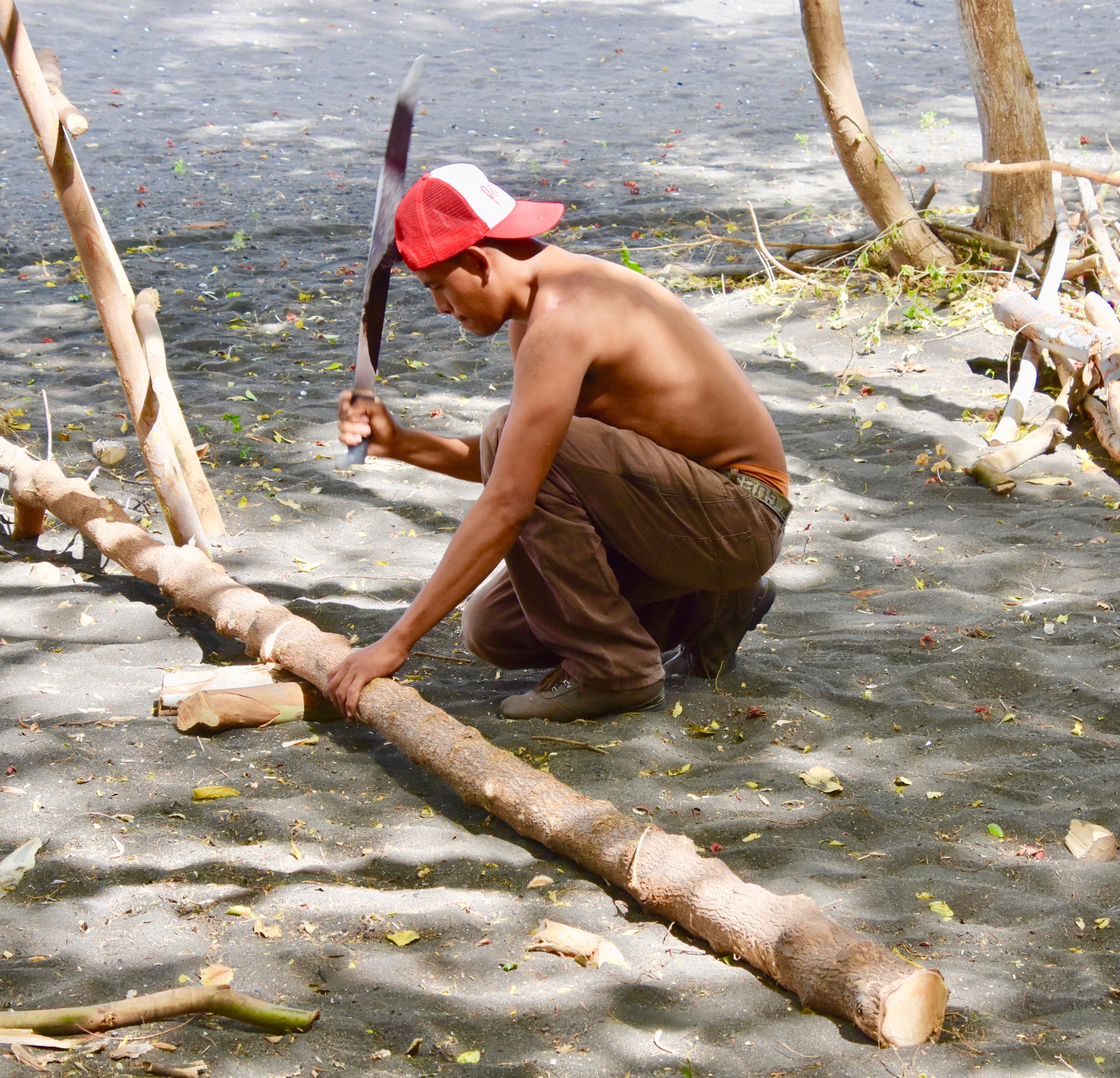
Walking back to the vans we come across a beautiful shrub with this flower which Aura identified as a tiger claw flower although that name is given to a number of flowers around the world. No matter what you call it, this is a nice plant with an even nicer Latin name, glorioisa superba. Alison is much more diligent than I am a taking pictures of the many varieties of flowers we have seen in Nicaragua. Suffice it to say that the countryside is a riot of bloom and a treat to the eyes.
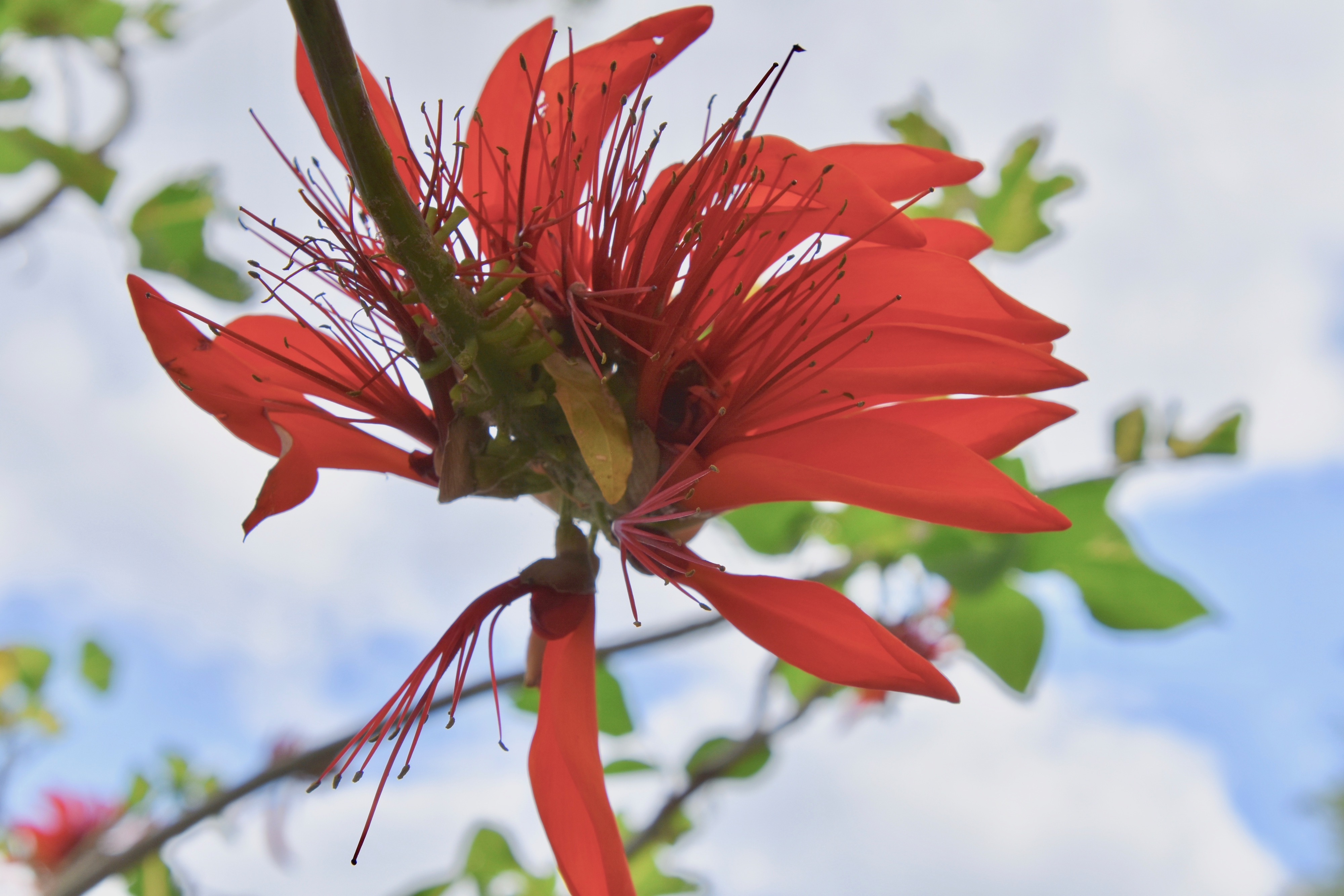
Our next stop is still on this country lane where we come upon a crop that, to my knowledge is no longer grown in Canada, but once was a staple of southwest Ontario and Prince Edward Island. I’m talking about that most evil of plants, tobacco. We are constantly told of how many millions of people from the New World died from diseases, wittingly or unwittingly introduced by the Europeans. However, the New World gave the Old World tobacco and the number of deaths it has caused over the centuries would dwarf those killed by disease from the 15th to the 18th century. So the last laugh goes to the Indigenous chief who first gave Sir Walter Raleigh a smoking plant to inhale and got the world hooked.
I’m being facetious of course. No plant is good or evil, but it is the use we make of it that matters, whether for good or bad purposes. This a field of Nicaraguan tobacco which will become a component in cigars that Aura assures us are now the best in the world, surpassing Cuba’s, despite it’s reputation. A little research confirms indeed that the deep rich black volcanic soils of Nicaragua are the perfect growing medium for high quality tobacco. If you are a gardener you will be familiar with nicotiana or flowering tobacco which is very fragrant and a Canadian garden favourite.
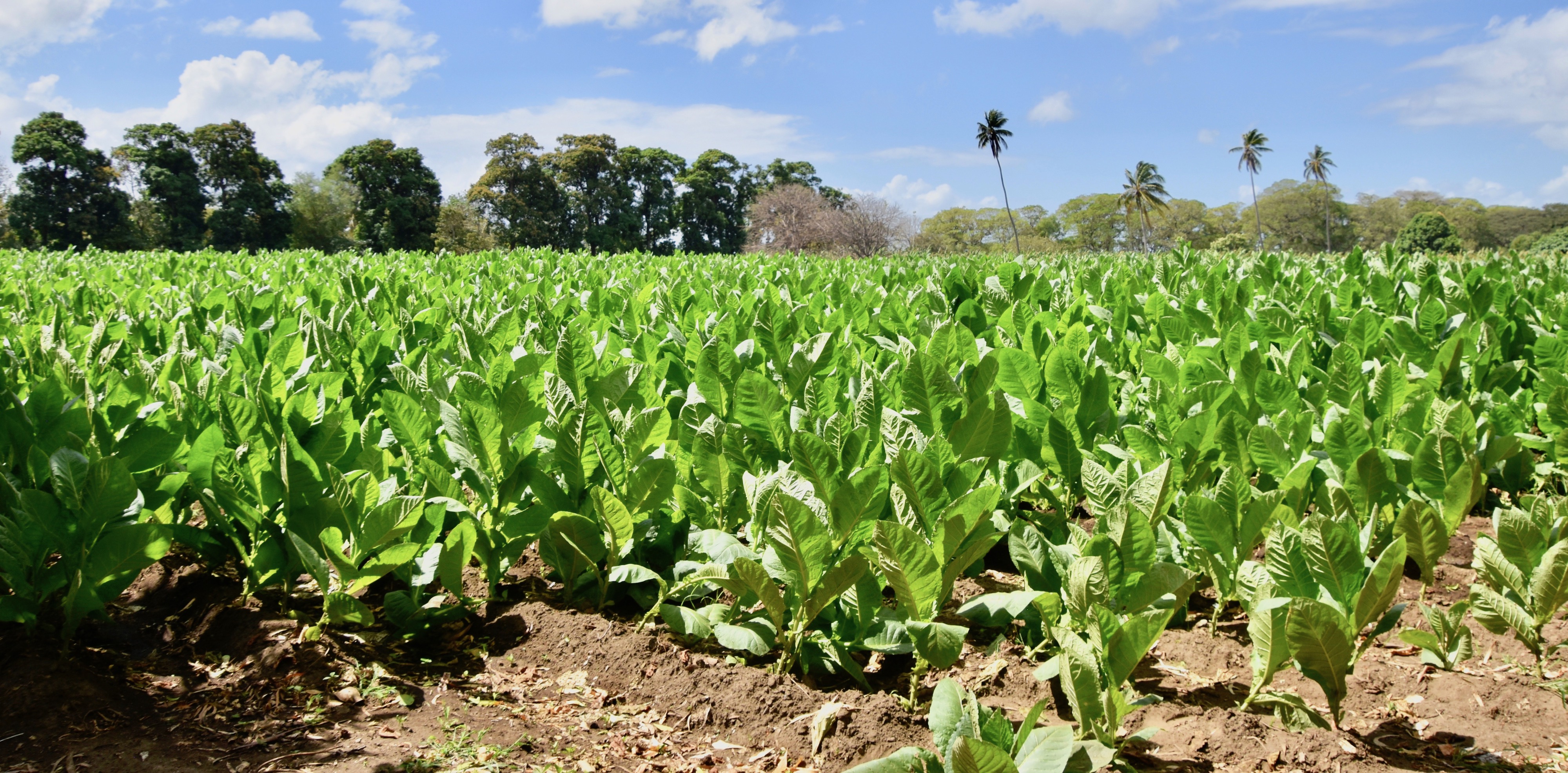
Moving back onto the main road and deeper into the countryside it quickly becomes apparent that Ometepe Island still relies heavily on domestic animals for transportation like this plantain salesman heading to market.
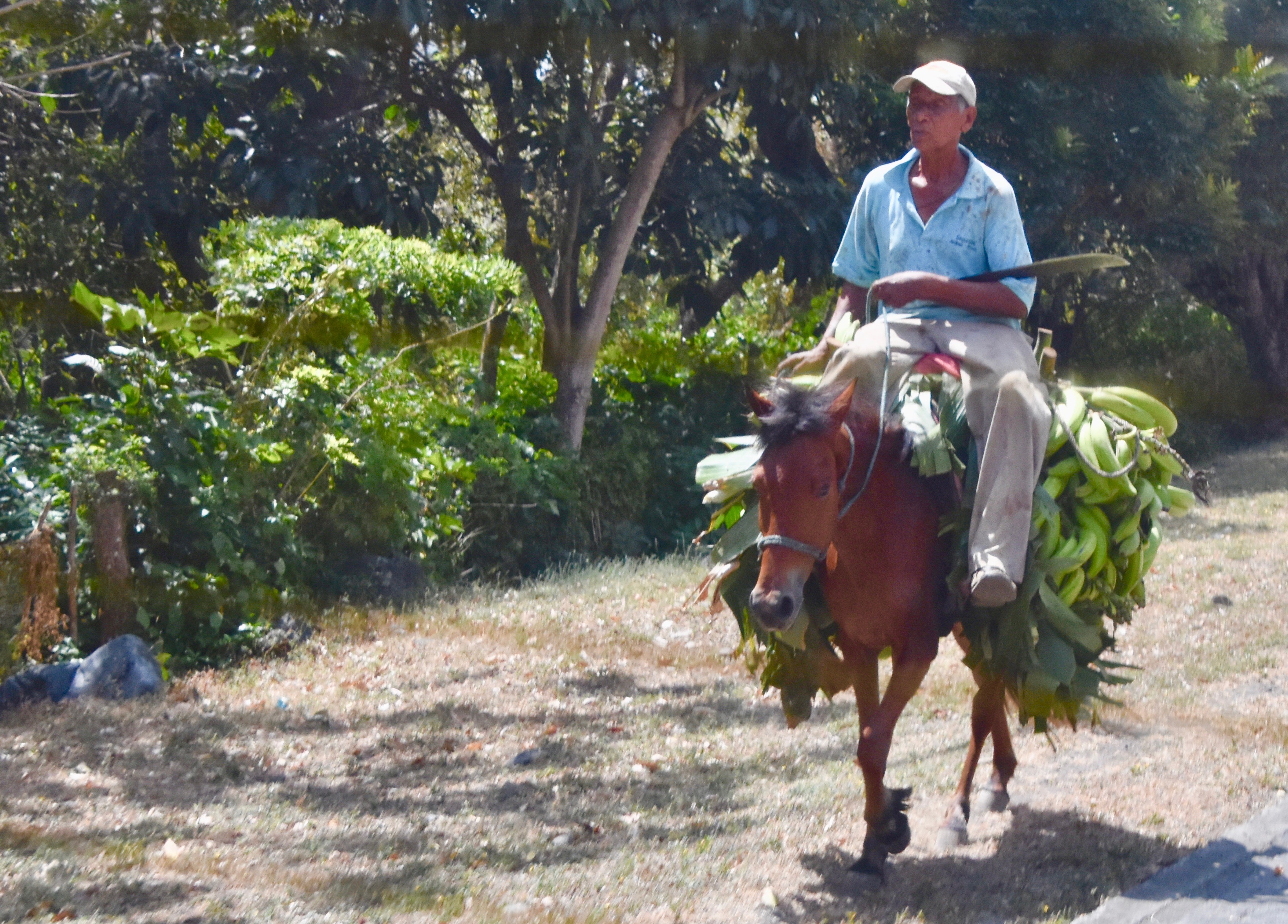
It’s been decades since oxen teams were used to haul logs from the forests of my home province of Nova Scotia, but here I saw many, using the brahman cattle that originated in India, but were actually developed into a source of beef in United States over 140 years ago. They are inured to hot and humid weather and are perfect for a country like Nicaragua.
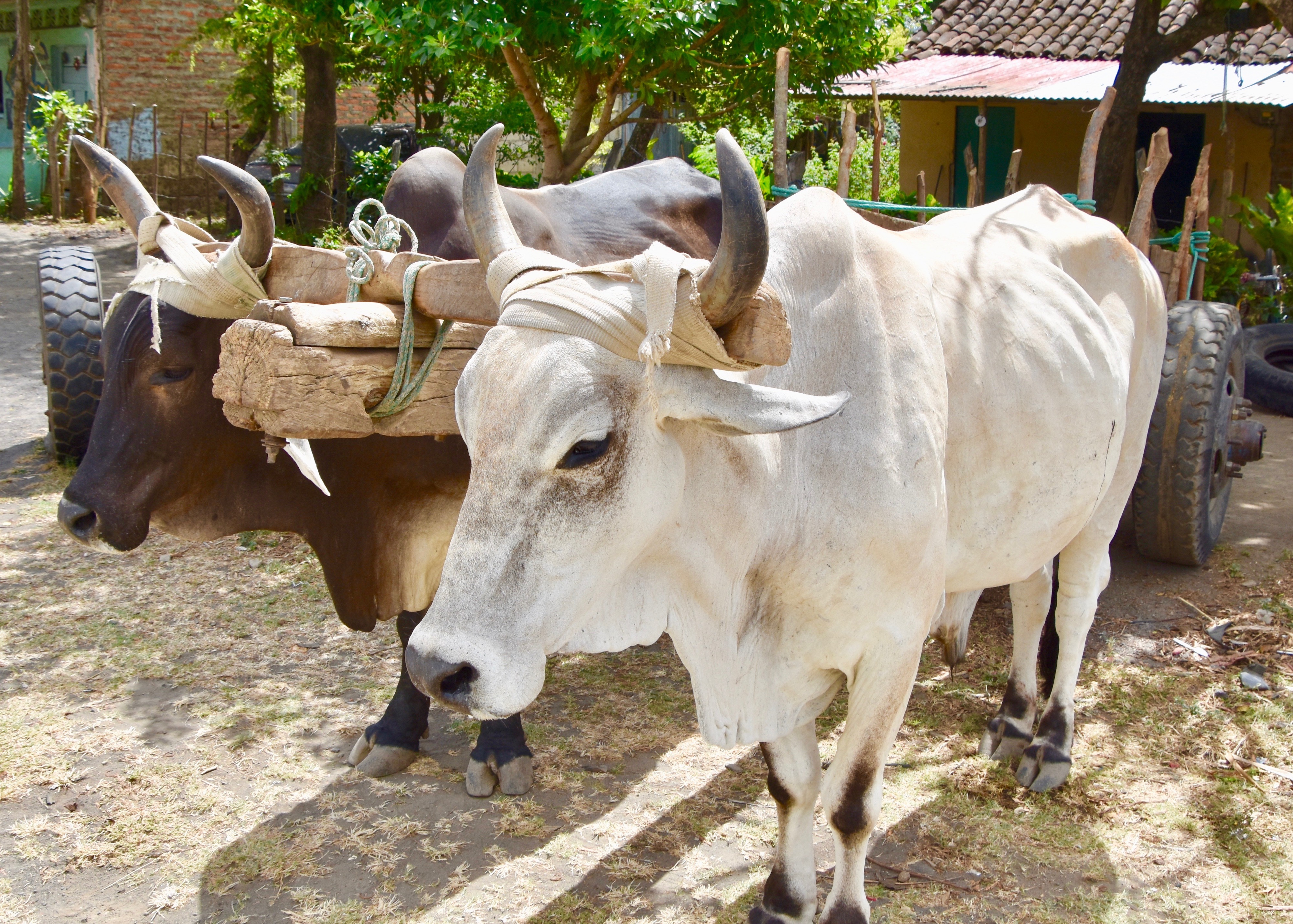
After a while we arrived in the town of Altagracia which was bustling with activity. Aura led us to a public area beside the Catholic church where a number of pre-Columbian artifacts are on display. For years these were kept hidden in the basement of the church and considered blasphemous. They were put on display only after there enough of a public outcry about the church trying to bury the Indigenous past of Ometepe which, not surprisingly given the two volcanoes on an island in a lake, was considered a sacred site. Even now the church cannot resist describing the artifacts as ‘idols’, a clear reference to the first commandment forbidding ‘idolatry’.
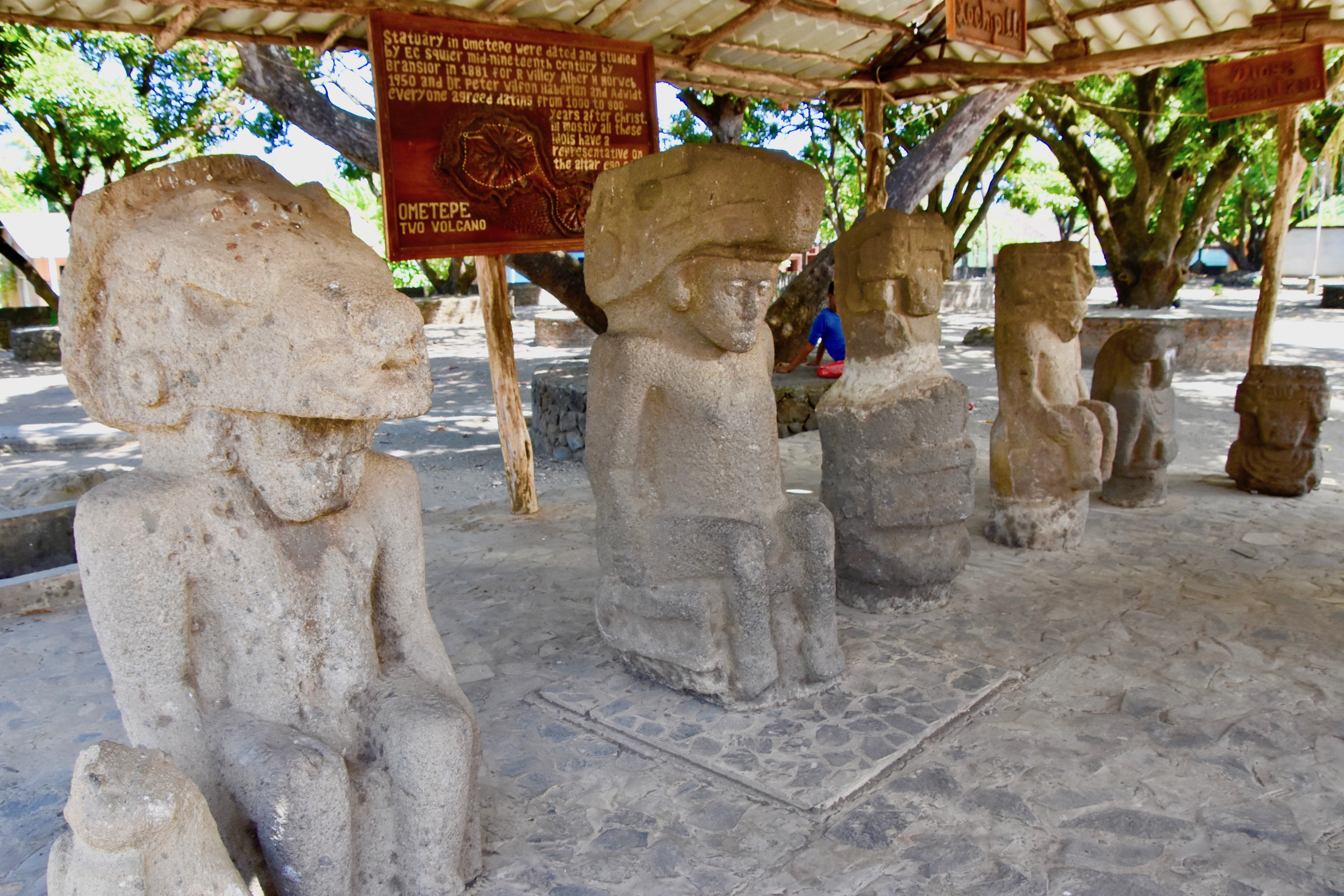
In the centre of Altagracia there is a huge model of the island and looking at it you can really visualize just how much of Ometepe is dominated by the two volcanoes. There’s really nothing else like it on earth – Ometepe that is, not the model.
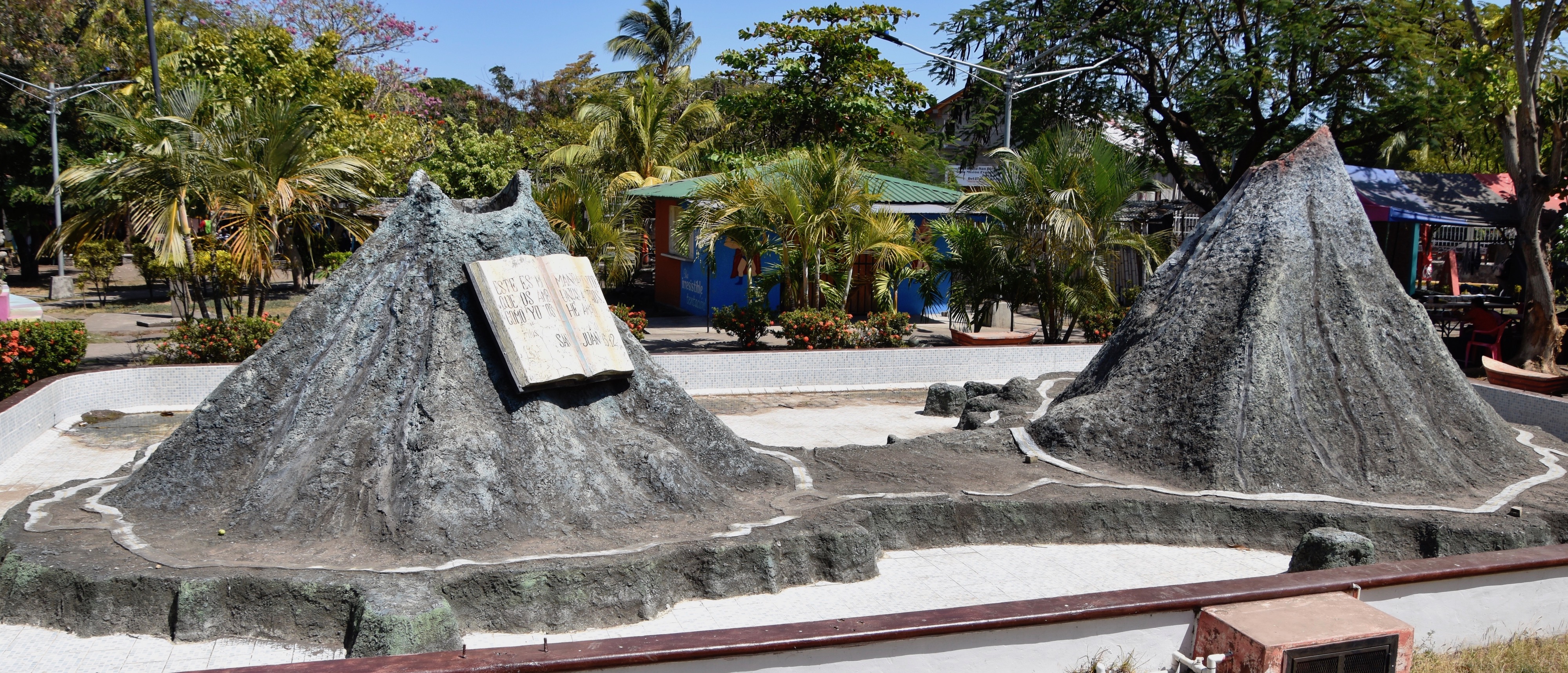
Leaving Altagracia we continued along the lakeshore to Villa Paraiso where we stopped for lunch at their restaurant that overlooked a playa on Lake Nicaragua in a another beautiful tropical setting.
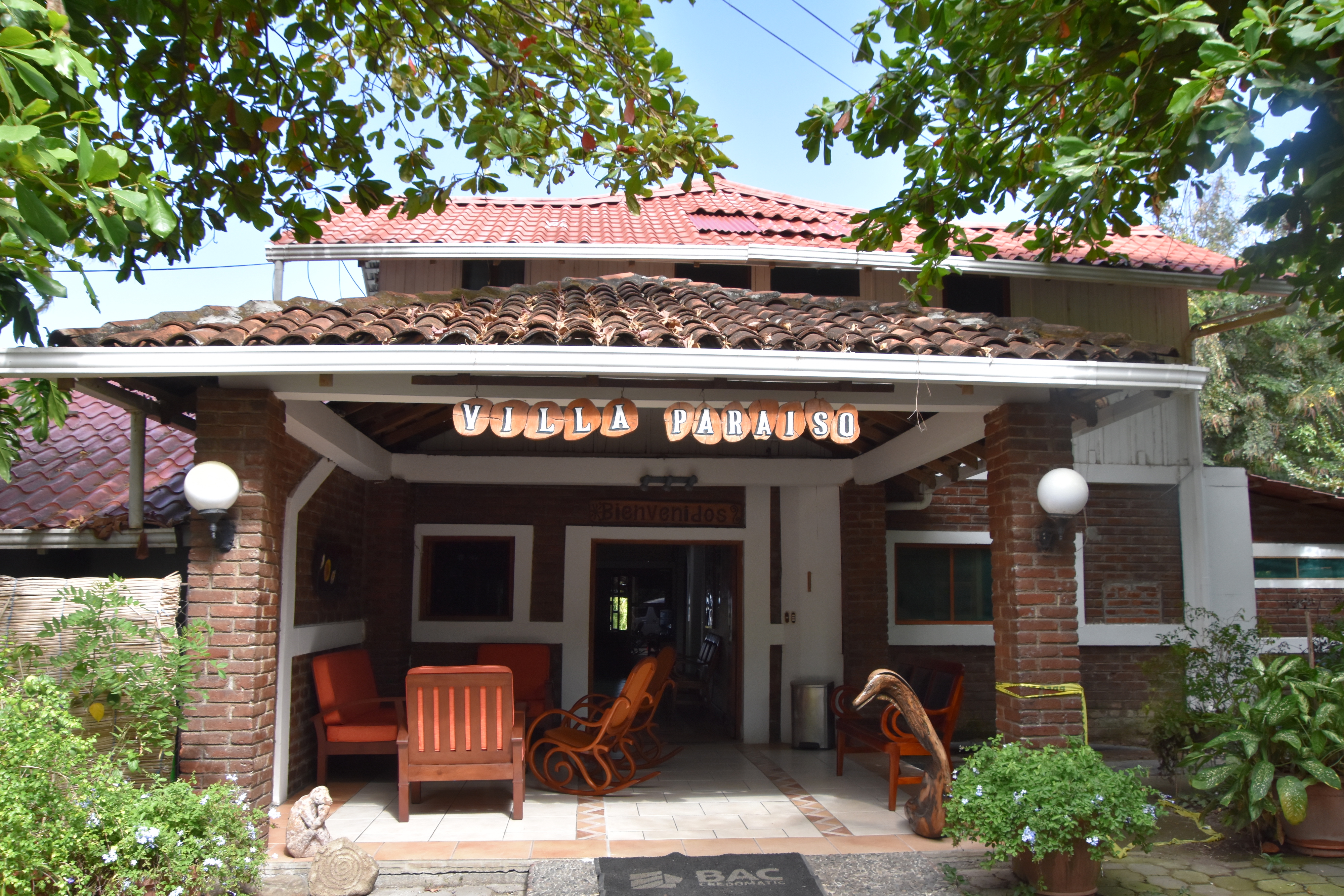
Almost immediately upon being seated we were greeted by a flock of bold magpie jays who couldn’t wait for us to get our meals so they could try to steal some. These are very pretty birds with all of the mischievous instincts of both jays and magpies.
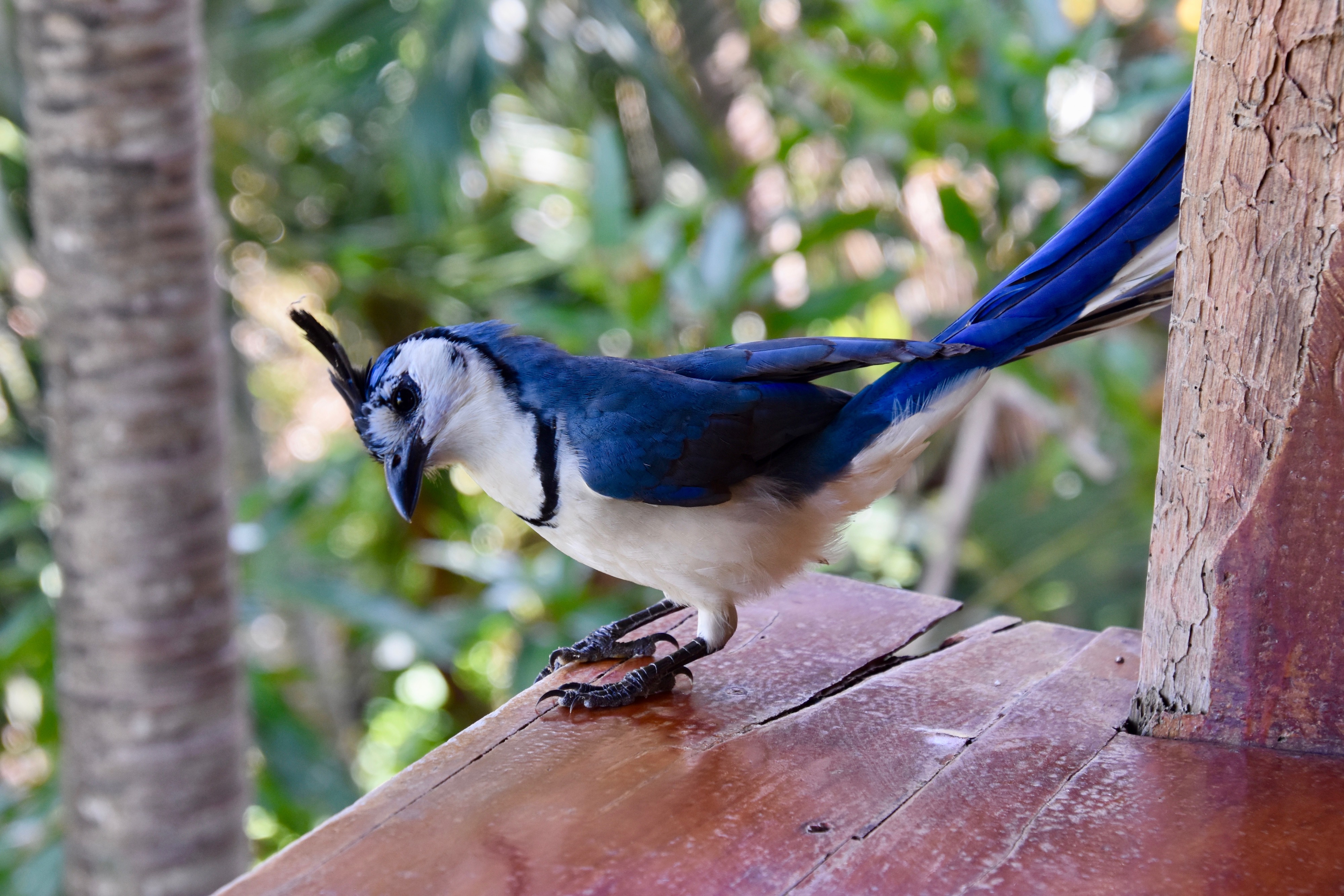
I remembered my self-admonition to avoid the red meat and ordered the grilled chicken skewers which turned out to be a very wise decision – not because there was anything wrong with the beef, just that this chicken kabob was amazingly tender and flavourful. Easily the best I’ve ever had. Go figure.
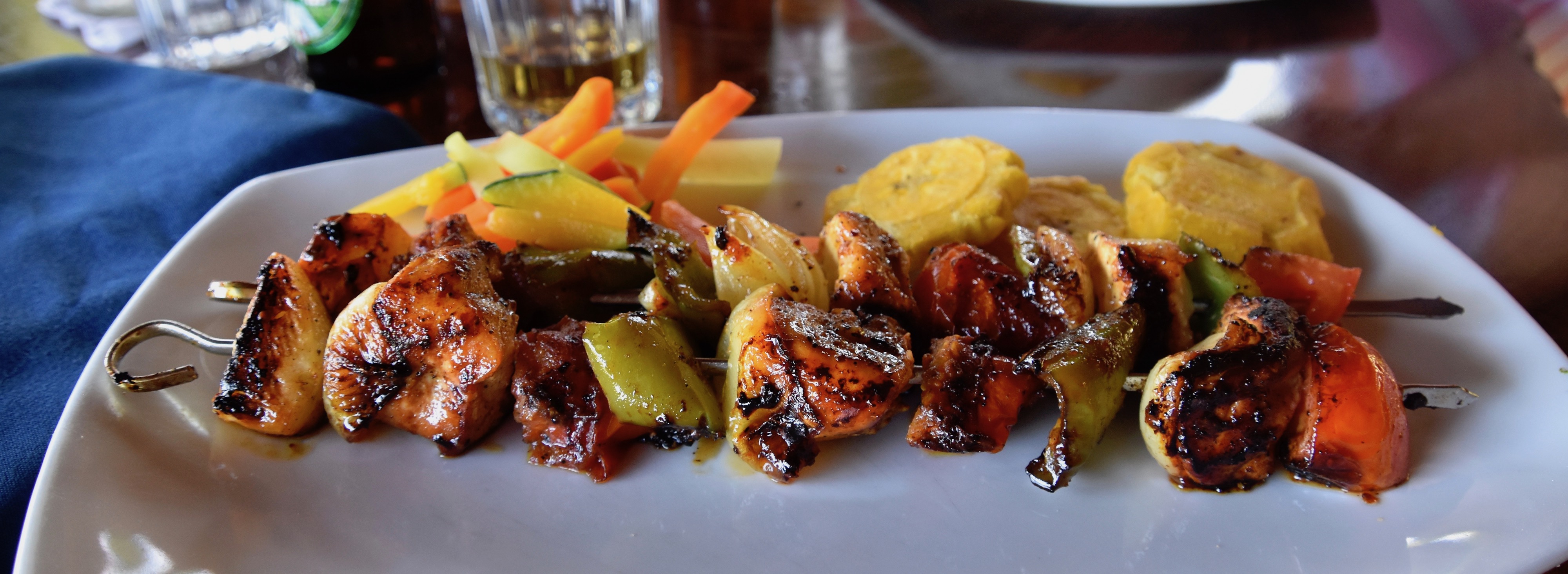
After lunch we headed back to Moyogalpa, but made a quite stop at the airport along the way. Say what?
They’ve built a new landing strip on Ometepe that crosses the main highway just outside of Moyogalpa and of course closes it when the once weekly flight comes in, similar to what happens in Gibraltar. The upside is that the runway is perfectly positioned to provide great views of Concepción. By now most of the cloud that was hiding it earlier in the day had dissipated and the volcano was at its finest as demonstrated by this photo I took of Alison.
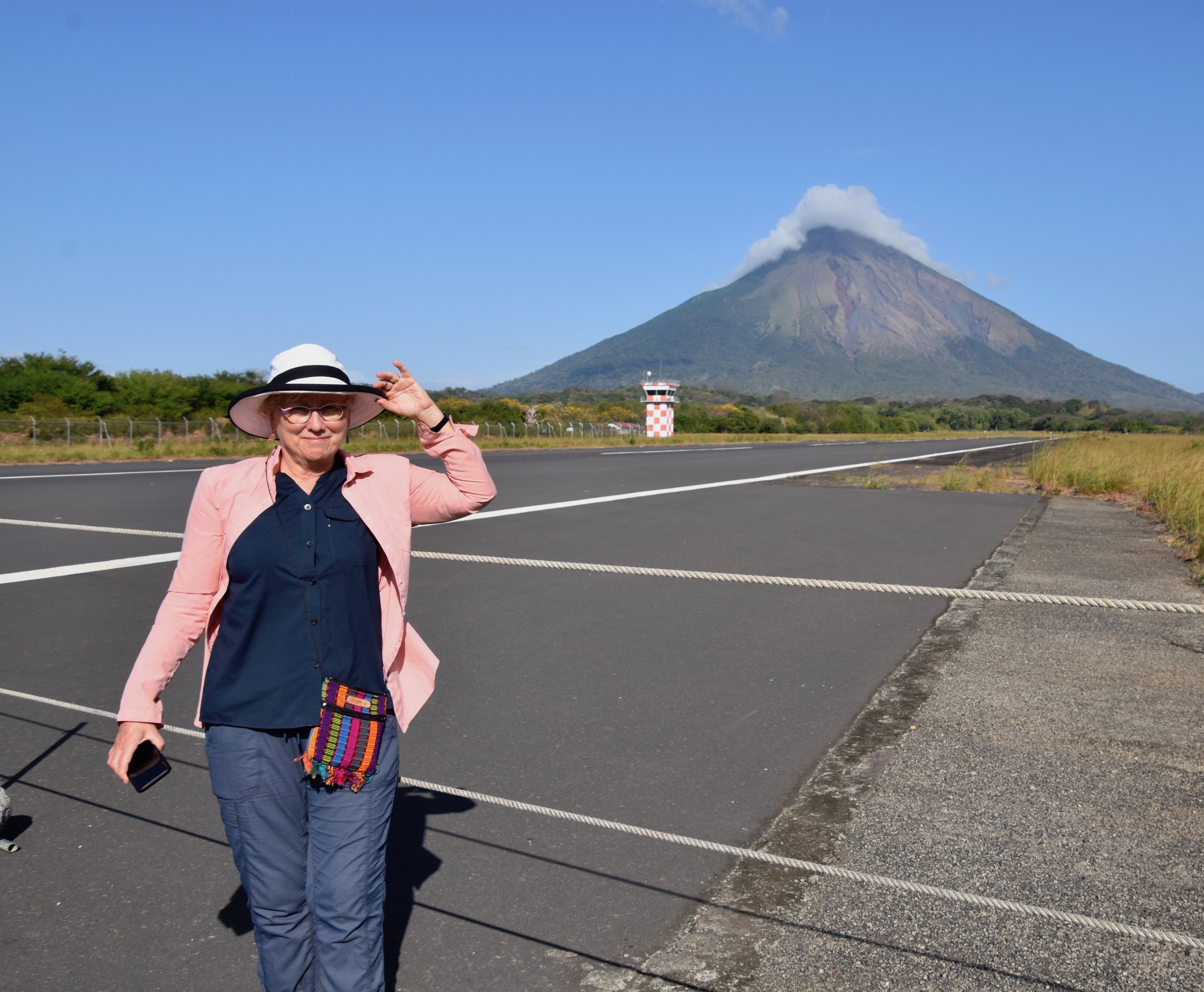
Arriving back at the ferry terminal just in time for the next ferry to dock I couldn’t help but compare it to those boatloads of migrants that try to make the crossing of the Mediterranean in overcrowded boats. It seemed that for every person leaving Ometepe another dozen were arriving.
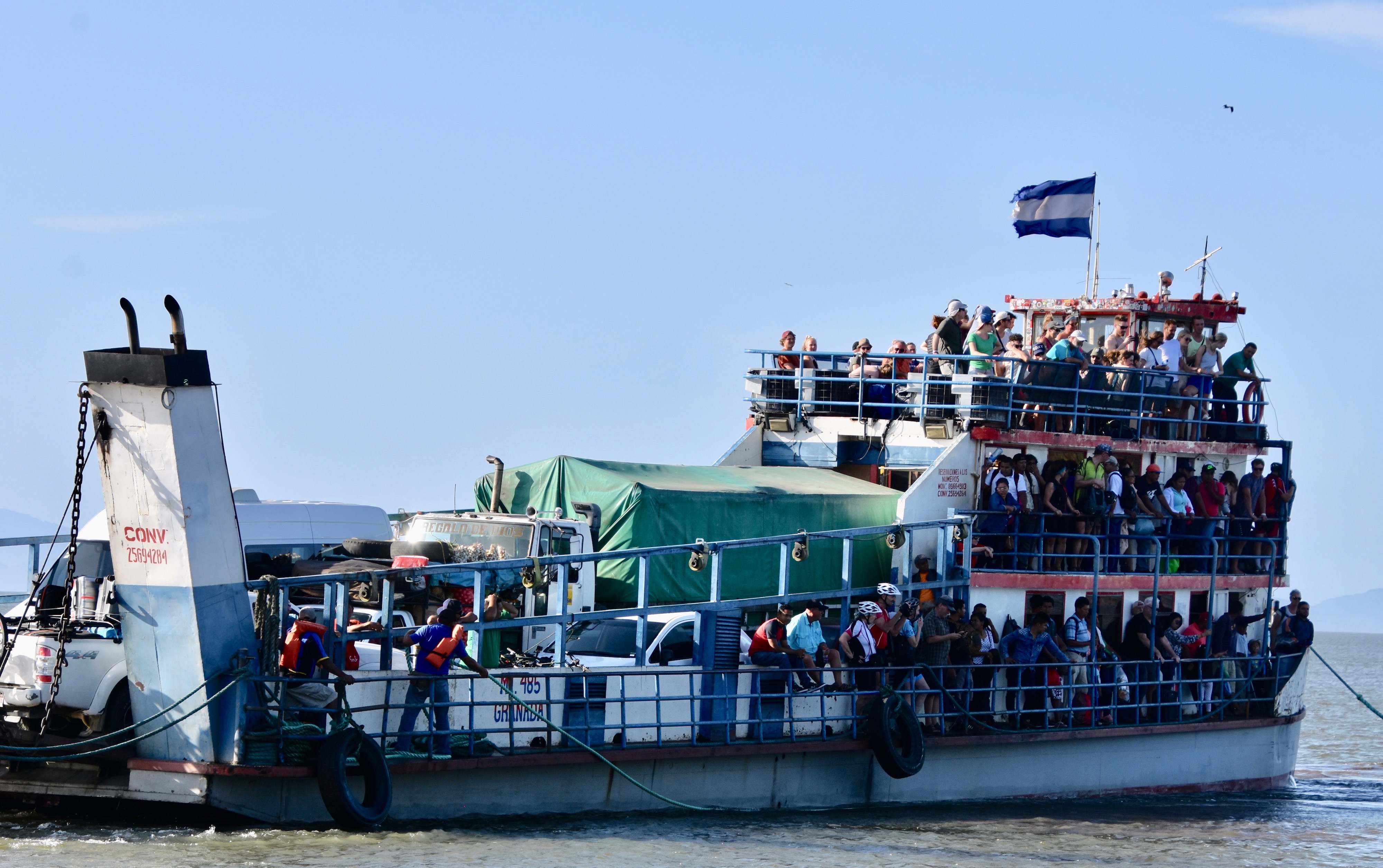
Our trip back to the mainland was an uneventful three Toña crossing and by nightfall we were back at the hotel in Granada with the trip to Ometepe now a memory and not an anticipation, but once again on this tour a memory that will last a lifetime.
Next we are off to the other old colonial city of Nicaragua, Leon. See you there.
Many thanks again to Dale for his wonderful insights and allowing us to share his words and photos with you.